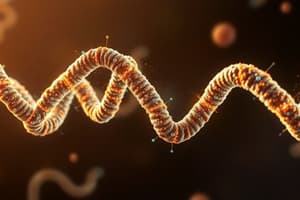Podcast
Questions and Answers
What is the term for a protein that has lost its native shape due to external factors?
What is the term for a protein that has lost its native shape due to external factors?
- Hydrolyzed
- Renatured
- Denatured (correct)
- Solubilized
Which of the following amino acids is commonly involved in protein structure?
Which of the following amino acids is commonly involved in protein structure?
- Threonine
- Hexamine
- Glycine (correct)
- Cytosine
What characteristic does proline contribute to protein structure?
What characteristic does proline contribute to protein structure?
- Hydrogen bonding capability
- Increased solubility in water
- Kinks in polypeptide chains (correct)
- Helical structure
Which amino acid is known to be polar and can form hydrogen bonds?
Which amino acid is known to be polar and can form hydrogen bonds?
Which of the following amino acids can be classified as an amide?
Which of the following amino acids can be classified as an amide?
What is one of the primary functions of proteins in biological processes?
What is one of the primary functions of proteins in biological processes?
Which process directly involves proteins ensuring that other proteins are correctly shaped?
Which process directly involves proteins ensuring that other proteins are correctly shaped?
Which of the following is NOT a function of proteins?
Which of the following is NOT a function of proteins?
What is a function of proteins involved in cellular processes?
What is a function of proteins involved in cellular processes?
Which protein structure level is determined by the sequence of nucleotides in mRNA?
Which protein structure level is determined by the sequence of nucleotides in mRNA?
What is the first level of protein structure, which consists of a sequence of amino acids?
What is the first level of protein structure, which consists of a sequence of amino acids?
Which protein structure is characterized by the folding of the polypeptide chain into alpha helices and beta sheets?
Which protein structure is characterized by the folding of the polypeptide chain into alpha helices and beta sheets?
At which level of protein structure do different polypeptide chains come together to form a functional protein?
At which level of protein structure do different polypeptide chains come together to form a functional protein?
What reaction type is responsible for forming a peptide bond between two amino acids?
What reaction type is responsible for forming a peptide bond between two amino acids?
Which level of protein structure represents the overall 3D shape of a single polypeptide chain?
Which level of protein structure represents the overall 3D shape of a single polypeptide chain?
Which method is used to separate proteins based on their size?
Which method is used to separate proteins based on their size?
What technique relies on the charge of proteins rather than their size?
What technique relies on the charge of proteins rather than their size?
Which separation method utilizes a specific binding affinity to isolate proteins?
Which separation method utilizes a specific binding affinity to isolate proteins?
Which method involves the migration of proteins through a gel matrix?
Which method involves the migration of proteins through a gel matrix?
Which of the following methods would be least effective for size-based separation?
Which of the following methods would be least effective for size-based separation?
Which type of bond forms the backbone of a protein’s primary structure?
Which type of bond forms the backbone of a protein’s primary structure?
What role do disulfide bonds primarily play in protein structure?
What role do disulfide bonds primarily play in protein structure?
Which bond is most important for the formation of a protein’s primary sequence?
Which bond is most important for the formation of a protein’s primary sequence?
What is the main function of chaperone proteins?
What is the main function of chaperone proteins?
Which bond is primarily responsible for holding together two separate protein chains through sulfur atoms?
Which bond is primarily responsible for holding together two separate protein chains through sulfur atoms?
Flashcards are hidden until you start studying
Study Notes
Protein Structure
- Primary structure refers to the linear sequence of amino acids in a polypeptide chain.
- Secondary structure describes the local folding patterns of the polypeptide chain, such as alpha helices and beta sheets, stabilized by hydrogen bonds.
- Tertiary structure refers to the overall three-dimensional shape of a single polypeptide chain, formed by interactions between side chains of amino acids.
- Quaternary structure describes the arrangement of multiple polypeptide chains (subunits) in a protein complex.
Peptide Bond Formation
- The reaction involved in forming a peptide bond between two amino acids is a dehydration reaction, where a water molecule is removed.
Amino Acids
- Glycine is the simplest amino acid with a hydrogen atom as its side chain.
- Proline is a unique amino acid with a cyclic side chain that restricts its flexibility.
- Serine is a polar amino acid with a hydroxyl group in its side chain.
- Glutamine is a polar amino acid with an amide group in its side chain.
Protein Denaturation
- Denaturation refers to the loss of a protein's native shape due to factors such as heat, pH change, or chemical agents.
- Denatured proteins typically lose their biological function.
Protein Backbone
- The backbone of a protein's primary structure is formed by peptide bonds between the amino group of one amino acid and the carboxyl group of the next.
Chaperone Proteins
- Chaperone proteins assist in the correct folding of proteins, preventing aggregation and misfolding.
Protein Structure and mRNA
- The sequence of nucleotides in mRNA directly determines the primary structure of a protein.
Protein Separation Techniques
- Gel filtration chromatography separates proteins based on their size, with larger proteins eluting first.
- Electrophoresis separates proteins based on their charge and size, with smaller and more highly charged proteins migrating faster towards the positive electrode.
Studying That Suits You
Use AI to generate personalized quizzes and flashcards to suit your learning preferences.




